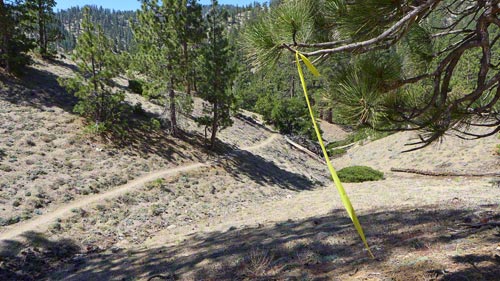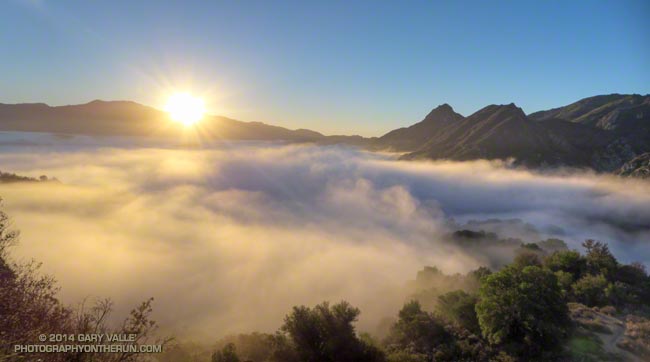
The sun rises over the shoulder of Saddle Peak illuminating a shallow layer of fog in Malibu Canyon.

The sun rises over the shoulder of Saddle Peak illuminating a shallow layer of fog in Malibu Canyon.
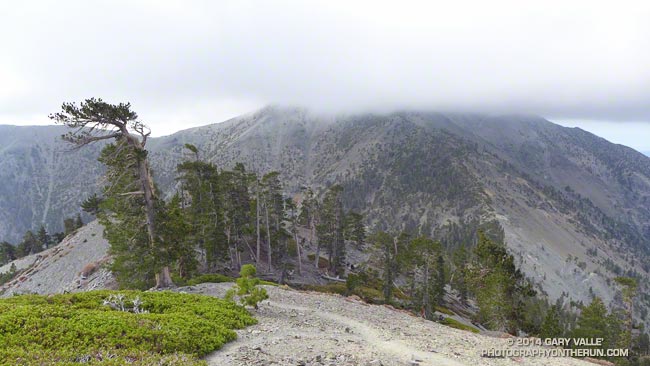
Mt. Baldy from the North Backbone Trail
According to my car’s thermometer the temperature in the west San Fernando Valley was 86 degrees. To the east a large patch of middle-level clouds had morphed into a large lenticular cloud. Over the course of a few minutes the wave cloud continued to transform, dividing into a train of alto-cumulus waves.
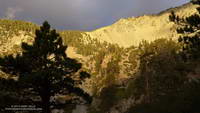
I just shook my head. A few hours earlier and 60 miles away, I had been freezing. The plan had been to do a “Baldy Over the Top” run to the old juniper on the north side of Pine Mountain. Around 8:45 am, as running partner Ann Ongena and I crested the cloud-capped, 10,064′ summit of Mt. Baldy, the wind chill temperature had been around 30 degrees. The air temperature was in the low 40s, but with the wind blowing at least 40 mph and gusting to over 50 mph it had been brutally COLD. Especially in running shorts.
Spending zero time on the summit, we waved to the hikers huddled in the rock windbreaks as we sprinted by. The hope had been that the wind (and temperature) would moderate as we descended the North Devil’s Backbone on the back side of Baldy.
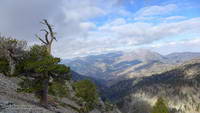
It didn’t. Wind-driven clouds continued to sweep past the ridge as we ran down the steep path. At the first opportunity we stopped in the wind shadow of a clump of stunted lodgepole pines and put on wind/rain shells. The shells were three ounces of magic — without them it would have been foolhardy to continue.
As we descended to the Baldy – Dawson Saddle and then climbed up to Dawson Peak I kept looking back over my shoulder to the cloud-shrouded summit of Mt. Baldy. Were there more clouds? Was the ceiling lower? Was there more vertical development?
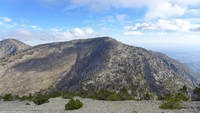
The day before I had checked the forecast from the NWS and the forecast models. A dissipating cold front was approaching the area from the north, but wasn’t expected to pass through until sometime tonight. No measurable rain was forecast for the Los Angeles area. The last time I had checked no clouds had been forecast for Saturday morning — but there they were. I had expected some southwesterly winds ahead of the front, but nothing like this.
I didn’t like being on the back side of the mountain in potentially bad weather knowing that “home” was on the front side. We had just enough gear to deal with the current conditions. I didn’t think it was very likely, but if the weather deteriorated…
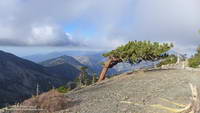
Many of the incidents that occur in the outdoors are the result of a series of misjudgments. If you’re already on the edge it’s usually best to call it before things get REALLY complicated.
And that’s exactly what we did. After descending a short distance down the ridge from Dawson Peak we turned around. Even if the outing was going to be a bit shorter than planned, it was still going to be an outstanding hike and run in extraordinary conditions with over 6000 feet of elevation gain.
It was just as windy, cold and cloudy on the second trip over the top of Baldy as it had been on the first and we spent about the same number of milliseconds on the summit before picking up the Devil’s Backbone trail and running down.
Some related posts: Mountain Weather, Atmospheric Dynamics
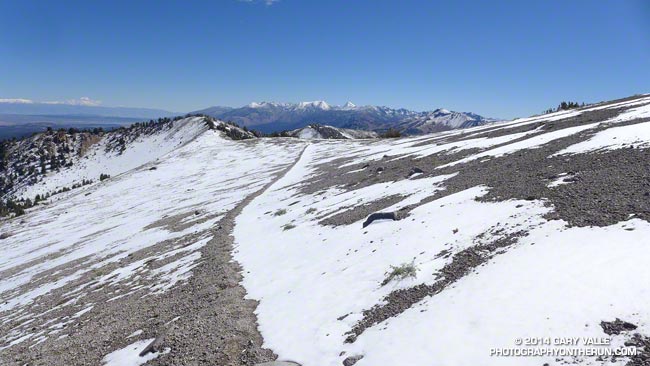
With this year’s El Nino developing in fits and starts and drought-plagued California clinging to hopes of an above average snowpack, a little September snow is a big deal, even if it’s just a dusting.
The first low pressure system of Fall resulted in significant rain in many areas of Central and Northern California, with amounts falling off quickly to the south. According to the NWS, Redding recorded over 3 inches of rain; Red Bluff nearly 2.5 inches; South Lake Tahoe 1.8 inches; Downtown Sacramento and San Francisco both recorded about 0.5 inch.
For a rain-starved, heat-desiccated Southern Californian it was great to get out and play in the snow. I had a window of about three hours to do a run and the run/hike up San Joaquin Ridge from Minaret Summit was superb!
Here are a few photos from the run.
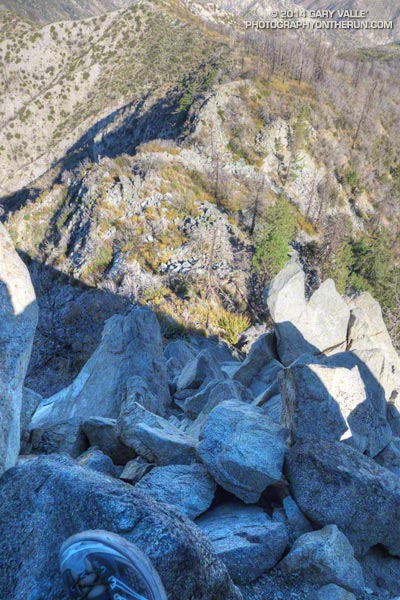
It was about 8:30 a.m. and I was nearly to the top of the steep, rocky ridge on the west side of Strawberry Peak. I gazed over the rocks and ridges to the layer of stratus that partially filled the Los Angeles basin and valleys and tried to find Saddle Peak or Castro Peak. These peaks would mark the location of Malibu Creek State Park. Today some friends were doing the Bulldog 50K and I wondered if the marine layer was too shallow to take the edge off the heat forecast for later in the day.
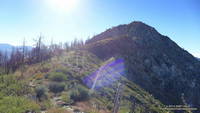
The loop over the top of Strawberry Peak is a more adventurous variation of the Strawberry Peak Circuit. Closed for 4 1/2 years by the Station Fire, the trails necessary to do the circuit and approach the peak — Josephine Peak Fire Road, Strawberry Spur Trail, part of the Colby Canyon Trail and Strawberry Peak Trail — reopened in late May. The trails from Josephine Saddle to the summit of Strawberry and from the summit down to Lawlor Saddle are unofficial paths created by use.
I’d done the circuit around Strawberry in July a couple of weeks before the Angeles Crest 100. Today’s hike, run and climb over the top of the peak was a fun way to continue to recover from the exertions of that event. As was the case with the Strawberry Peak Circuit, I started the loop at Clear Creek, but it is also possible to start at Switzer’s Picnic Area or Red Box.
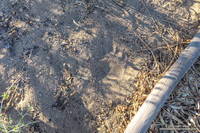
Like anything adventurous, if it’s in your comfort zone the challenges can be fun; if not, the adventure can quickly turn into a nightmare. This route requires rock climbing and route-finding skill and a bad choice can ruin your whole day. Strawberry Peak has been the site of numerous search and rescue operations. The rock on the west side of the peak is of variable quality and if you go off-route it’s easy to become trapped in a spot where you can’t safely go up or down.
Not only is the route-finding tricky on the rock climbing sections. As a result of the growth of Poodle-dog bush following the Station Fire, the use trail on the upper ridge on the west side of the peak is more circuitous than it used to be. Although much of the Poodle-dog bush was wilting and in some cases dying, it can still cause dermatitis. By staying on the use trail it was mostly avoidable. There was a bear track on this section of the ridge and I wondered if the tracks I’d seen on the Strawberry Peak Circuit were from the same bear.
The last section of rock climbing ends abruptly just below the summit. The use trail on the east side of the summit involves no rock climbing and sees much more traffic. Though steep and loose, by fell-running standards it is mostly runnable. At Lawlor Saddle the maintained trail begins and continues to Red Box. From there the loop is closed using the Gabrielino Trail and Nature’s Canteen Trail. Since I was last on the trail in July, the Nature’s Canteen Trail had been re-cut and was in great shape.
Some related posts: Strawberry Peak Traverse, Strawberry Peak Circuit
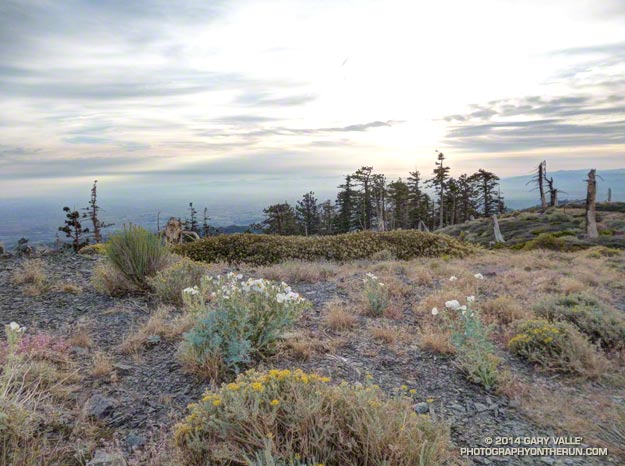
As I chugged up the Acorn Trail the eastern sky kept pace, becoming increasingly brighter with each stride. Dawn revealed a red-tinged layer of high clouds illuminated by a muted sun. This was good news. As late as Thursday afternoon the NWS forecast for the Los Angeles County Mountains on race day had been for typically hot AC100 weather:
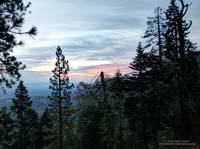
.SATURDAY…SUNNY. HIGHS FROM 90 TO 100 AT LOW ELEVATIONS TO THE
UPPER 70S TO MID 80S AT HIGH ELEVATIONS. SOUTHWEST WINDS 15 TO 25
MPH IN THE AFTERNOON.
.SATURDAY NIGHT…MOSTLY CLEAR IN THE EVENING THEN BECOMING PARTLY
CLOUDY…
But even in Southern California in the dog days of Summer the weather forecast isn’t a given. One wildcard was the summer monsoon. A surge of subtropical moisture was forecast to move into Southern California over the weekend and it wasn’t clear just how much of Los Angeles County would be affected. Another wildcard was a low pressure wave that computer models showed rotating up into the Los Angeles area Saturday night. This feature would destabilize the airmass, increasing the chance of precipitation. As things turned out, both wildcards came into play.
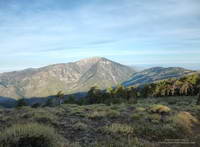
After topping out on the Acorn Trail and following the PCT to Inspiration Point the layer of high clouds continued to gradually thicken as I worked my way over to Vincent Gap, up Mt. Baden-Powell, and down to Islip Saddle. With the sun heavily shrouded, the temperature was a non-issue, neither too warm or cool, and perfect for running. At around 11:00 AM the Big Pines RAWS near Mountain High reached a high of 79 degrees and then dropped back down into the 60s between noon and 1:00 PM.
A bit past noon I ran across Hwy 2 and into the parking lot at Islip Saddle (mile 26). It looked and felt like it might start to rain at any time. The wind blew in fits and starts — as it does before a thundershower — and a few rogue sprinkles dotted the windshield of my car. I skipped the ice-water shower planned for this checkpoint, expecting that Mother Nature would probably take care of that all on her own.
Rather than an indicator of how hot and challenging the day was going to be, the climb from Islip Saddle to the Mt. Williamson summit trail was straightforward and in some sections actually a little breezy and chilly.
The somber skies accented the forms of the wind-shaped sugar pines along Kratka Ridge, and as I passed above Williamson Rock I wondered if ten years would be enough to get the climbing area and the closed segment of the Pacific Crest Trail open again. Running the final few yards into the Eagle’s Roost I was caught totally off-guard by the incredible aid station volunteers cheering, “Gary, Gary, Gary!”.
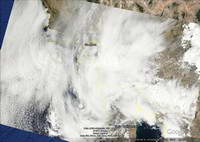
I didn’t think much about the weather between Eagle’s Roost and Cloudburst Summit. AC100 veterans had drilled into my head that the cutoff at Cloudburst was key. Make it through Cloudburst (mile 39) and you have a good chance of playing in the second half of the game.
With the cool weather the climb up Cooper Canyon was almost pleasant. The day before the high temperature at Chilao had been a warm 89 degrees, and the “in the sun” temp had been around 100 degrees. Race day it was much cooler and at a little before 3:00 PM, when I started up Cooper Canyon, the temperature at Chilao was in the low 70’s.
Of course there was a trade-off to all the subtropical clouds. About halfway between Cloudburst Summit and Three Points I heard a low rumbling to the east. I waited for it to transform into the muted roar of a jet flying overhead, but instead was treated to an even louder and more distinct rumble of thunder. As I ran down the PCT from time to time I would feel a large, cold drip of water on the back of a leg, and couldn’t quite tell if it was from my water bottle or the sky. The rumbles and raindrops continued on and off the remaining miles to Three Points.
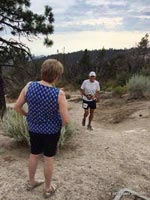
At Three Points (mile 44) I debated stuffing my three ounce shell into my waist pack. Several times I’ve experienced the fury and might of a big thunderstorm and know how quickly balmy temperatures can turn frigid in a deluge of rain, sleet and hail. About a half-mile after leaving Three Points it started to shower, and I hoped that leaving my shell there wasn’t a mistake. It continued to shower on and off over the next few miles, but gradually the rumbles of thunder decreased in frequency and so did the rain. (Had a strong cell developed in the Mt. Hillyer area it could have been a real problem, like it was for a number of runners in this year’s Tahoe Rim Trail 100.)
Another runner and I joined forces on the road up to Mt. Hillyer. Once we were through the aid station the main concern became getting down through Horse Flats and to Chilao before dark. We had headlamps, but not using them before Chilao was a benchmark we both wanted to make. Things still looked gnarly to the east. Beyond Mt. Waterman and Twin Peaks dark gray skies were decorated with obvious streamers of heavy rain. To the west a thin ribbon of cloudless sky brightened the horizon.
As we worked our way down to Horse Flats Campground and then over and down to Chilao the sun dropped lower and lower in the sky, eventually finding the horizon and illuminating the underside of the clouds with an increasingly saturated crimson red. There was just enough light to run as Dave and I pulled into the Chilao aid station (mile 54) and at least for the moment, it wasn’t raining.
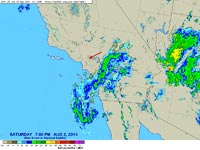
Judging from the rumble of thunder we heard just before leaving Chilao, the rain was not far behind. By the time Gary (my pacer) and I reached Poodle-dog Avenue on the way to the Charlton Picnic Area the showers were nearly continuous. The temperature was warm enough that it was a toss-up whether my rain shell helped or hurt. Here’s a NEXRAD radar animation of the rain from 7:00 PM to 10:00 PM Saturday evening as it swept across Los Angeles County. The red arrow is the approximate location of Shortcut Saddle.
It was still raining at 11:00 PM when we crossed a very wet Hwy 2 at Shortcut Saddle (mile 60.5) and started the never-ending descent to the West Fork San Gabriel River. Eventually reaching the nearly dry river, we laughed and thought back to March 2003, when we kayaked this stretch of river. Record rainfall had occurred the day before and we were worried the river would be too high. After carrying 70-80 lbs. of kayak and gear down the Silver Moccasin Trail we discovered the flow was perfect, and were able to complete the whitewater run from West Fork to Cogswell Reservoir and Hwy 39 before sunset.
Working up the hill to Newcomb Saddle it felt like I was carrying a kayak and it was definitely past sunset. Ideal running weather or not, my legs were just not cooperating. I would have several months to think about the run and what I’ve might have done differently. So many things have to come together to run a hundred miles.
The showers would continue sporadically through the night. One heavier shower occurred at about 3:15 AM at Newcomb Saddle (mile 69), after I had slept for an hour and just as we were getting ready to leave the aid station. It didn’t last long and most of our hike down to Chantry Flats (mile 75) was rain free.
Showers and thunderstorms continued in the San Gabriels on Sunday. One runner told me that leaving the Sam Merrill aid station he experienced the strongest winds he could recall encountering in the San Gabriels. From his description it sounded like it could have been the outflow of a downburst associated with a convective cell. Though runners did see some showers, the heaviest rain was in the high country in the area of Mt. Baldy and Mt. Baden-Powell. Mt. Baldy recorded 4.38 inches of rain from Saturday evening to Sunday evening. This resulted in flash flooding and numerous problems. The Big Pines RAWS recorded 1.53 inches and Crystal Lake 2.09 inches of rain over the same period. Here are some rainfall totals from the NWS (PDF) from around the area.
As you might guess the cool temperatures and showery weather were generally a big help to runners. The finishing rate this year was 66%, compared to about 60% in 2012 and 60.5% in 2013.
Related post: Why the Angeles Crest 100?
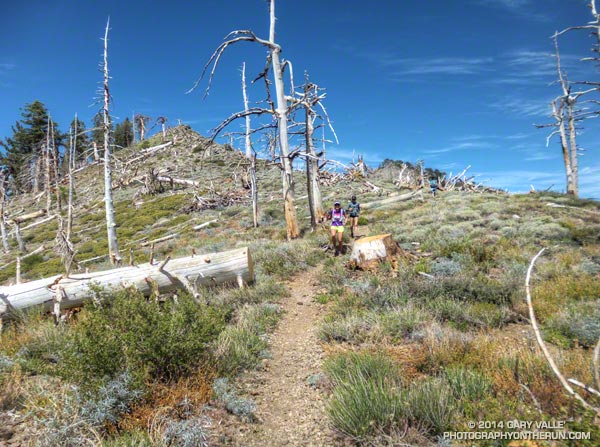
Between Vincent Gap and Islip Saddle the Pacific Crest Trail follows one of the most scenic stretches of trail in Southern California, skirting the summit of Mt. Baden-Powell (9399′) and passing Mt. Burnham, Throop Peak and Mt. Hawkins before leaving the crest at Windy Gap (7600′), just east of Mt. Islip. It has long been a favorite of hikers and runners.
There are several ways this classic stretch of trail can be incorporated into a run or hike. Today we were doing the segment as part of a training run for the 2014 Angeles Crest 100 Mile Endurance Run. The AC100 starts at Wrightwood, California; then using parts of the PCT, Silver Moccasin, Gabrielino and several other trails, the AC100 works west through the peaks and canyons of the San Gabriel Mountains to Loma Alta Park near JPL.
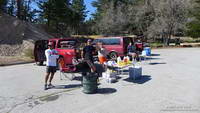
The AC100 training runs, organized and supported by AC100 co-director Hal Winton, cover the 100 mile course in approximately 25 mile segments. With the help of AC100 Racebook editor/photographer Larry Gassan and a host of generous volunteers, “Uncle Hal” makes it happen and always seem to be where runners need him to be. Today’s training run was the fourth, and last, of the 2014 series.
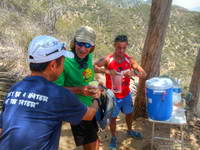
Just a few days before we’d done the third AC100 training run from Chantry Flats to the finish at Loma Alta Park. Beginning at Mile 75 of the AC100, this difficult segment includes the Wintercreek and Idlehour climbs and some of the most technical trails on the course. As a result of the drought water wasn’t easily accessible at Idlehour Creek, so Hal and 2013 AC100 finishers Dave Tan and Rainer Schultz were at the “Cape of Good Hope” on Mt. Lowe fire road to provide much-needed water to thirsty runners.
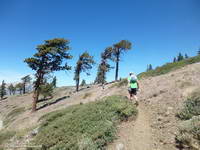
This morning’s run from Wrightwood had begun with an ascent of the Acorn Trail — a climb that matches foot for foot the 2650′ elevation gain of the PCT up Baden-Powell and is every bit as strenuous. After climbing up the Acorn Trail we’d joined the PCT and followed it along spectacular Blue Ridge, past the top of Mountain High Ski Resort, to Angeles Crest Highway at Inspiration Point. From there it had taken less than an hour to reach Vincent Gap and Hal’s aid station. A quick stop to refill my hydration pack and I was back on the PCT and chugging up Baden-Powell.
Far too many switchbacks later, far too much of the peak remained. I was maxed out and doing my best to keep up with Skye’s brisk pace. Finally we rounded a corner and I could see the Wally Waldron tree a 150 yards ahead. Just 150′ in elevation from the top of Baden-Powell, the gnarled and weathered limber pine — estimated to be 1500 years old — stands sentinel at the juncture of Mt. Baden-Powell’s summit trail and the PCT.
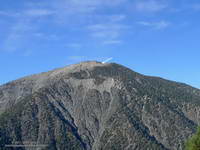
I’d pushed the pace up the Acorn and Baden-Powell climbs and now was paying the penalty. My legs were toast. When I’d reached the Wally Waldron tree the decision whether or not to go to the summit of baden-Powell had been very easy — one trail led steeply up and the other gently down. As we turned west onto the PCT I told Skye I was going to have to take it easy for a bit. She had already started to pick up the pace and it didn’t take long for her to disappear into the forest on the trail ahead.
After a while I glanced at my watch and was surprised to see that it was already 3:00 pm. Because of the long shuttle to Wrightwood we hadn’t started running until 9:20 am. After skirting Baden-Powell, I’d run past Mt. Burnham, struggled up to the shoulder of Throop Peak and now was near Mt. Hawkins. Here, the beginning of the descent to Windy Gap is marked by a prominent Jeffrey pine that has been struck by lightning.
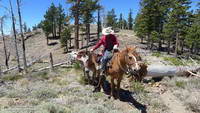
West of Mt. Hawkins the Pacific Crest Trail passes through a ghost forest of large trees burned in the 2002 Curve Fire. Recovery in the area is progressing well, and amid the dead trees are numerous pine and fir saplings. I ran this segment in mid-January and again at the end of May. Sometime between the two runs a large number of the dead trees had been blown down. During the May run it had been necessary to crawl over or work around a log jam of fallen trees. The trees likely blew down during a storm on February 28th, when Chilao recorded winds as high as 91 mph. That wasn’t necessary today, thanks to the expert trail work of PCTA volunteer Ray Drasher and his equine crew.
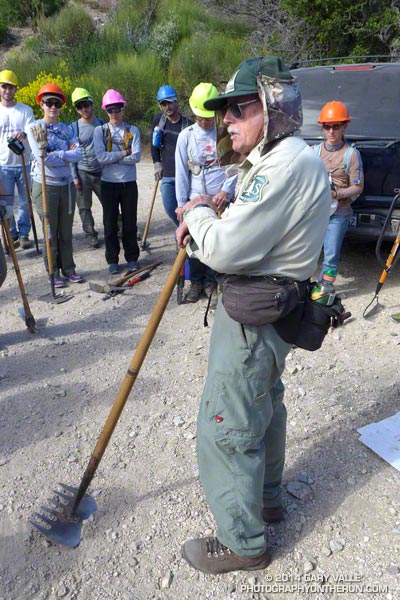
Most of the trail maintenance in the San Gabriels (and elsewhere) is now done by volunteers. One of the requirements to run in the AC100 is eight hours of trail work. This year AC100 entrants have worked on the Idlehour and Wintercreek Trails and will be working on the Gabrielino Trail below Newcomb Saddle in a couple of weeks. For more info about Hal and volunteering see the April 2014 issue of the VOLUNTEER TODAY newsletter (PDF).
Once through the ghost forest on Mt. Hawkins, it didn’t take long to get down to Little Jimmy Spring and from there over to Islip Saddle. It had been another tough training week in a series of tough training weeks. As I descended the final short switchbacks to the Islip Saddle parking area on Highway 2 I tried to visualize what it would be like on race day. How would I feel compared to today? Would I make here before noon? How hot would it be on Cooper Canyon? Would the cutoff at Cloudburst be a problem? Would I make it to Horse Flats before dark? On what trail would I be when sun rose for the second time during the run? All these and many other questions would be answered in just a few weeks.
